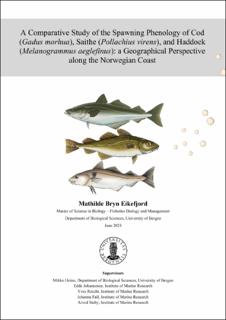| dc.description.abstract | Reproductive traits are a fundamental aspect of an organism's life history and play a critical role in shaping population dynamics, as these traits can significantly influence offspring survival rates and, thereby, reproductive success. The timing and location of spawning events influence offspring survival rates and recruitment success in fish populations, marking them as crucial study areas for fisheries management and conservation. This master thesis aims to investigate the spawning phenology of three ecologically and commercially important fish species collected along the ocean areas surrounding Norway, from the North Sea to the Barents Sea: cod (Gadus morhua), saithe (Pollachius virens) and haddock (Melanogrammus aeglefinus), focusing on identifying potential differences in the timing and location of their spawning. I used a large dataset on gonadal development collected from scientific surveys and fishing vessels. The study area including the North Sea, the Norwegian Sea and the Barents Sea was divided into three regions: North, Mid and South. The research revealed several new spawning sites for all three species, not currently included in the official spawning maps used for management. Furthermore, I found variations in the timing of the spawning event both between and within the three species. In general, saithe appeared to reach peak spawning first, followed by cod and then haddock reaching the peak spawning last. Moreover, the peak spawning occurred significantly earlier in the southern area compared to the more northern areas for all species. The study also revealed variations in the duration of the spawning season, with cod and saithe having an overall shorter spawning duration than haddock. Identifying differences in the timing and location of the spawning event among these species’ hints at unique adaptations to local environments. In summary, these findings provide important insights into the reproductive strategies of cod, saithe, and haddock from the North Sea to the Barents Sea. They further underscore the importance of research on the factors influencing the spawning. | |
